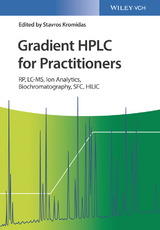Gradient HPLC for Practitioners
Wiley-VCH (Verlag)
978-3-527-34408-6 (ISBN)
The only practice-oriented guide for the optimal use of gradient separations in HPLC
This practical guide for analytical scientists explains the use of gradients in liquid chromatography, which account for the majority of chromatographic separations. After a description of the fundamentals of gradient separations, the most common application scenarios are addressed, from LC-MS coupling to biochromatography to the separation of ionic substances. Throughout, the book provides detailed, practical information for practitioners, enabling them to use gradient separation methods reliably and efficiently.
Gradient HPLC for Practitioners: RP, LC-MS, Ion Analytics, Biochromatography, SFC, HILIC starts by examining aspects of gradient optimization - looking at special features of the gradient, some chromatographic definitions and formulas, and a set of easy-to-remember rules of thumb when setting up a gradient HPLC. It then provides readers with both linear and curvilinear models to study the prediction of gradients. Next, it examines the requirements, optimal use, hints, and pitfalls of the gradient itself - presenting instrumental influences in gradient elution, gradient elution technology, and ways to systematically characterize gradient instrumentation. Other topics covered include use of gradients in LC-MS; specifications of gradients in biochromatography; the gradient in the separation of ionic components; use of gradients in hydrophilic interaction liquid chromatography (HILIC); and gradient elution in supercritical fluid chromatography (SFC).
-Captures the experience and technological advances in gradient HPLC of the past decade
-Addresses everyday analytical challenges of novice and routine users
-Examines the detection limit, peak capacity, and resolution in gradient optimizations, as well as gradient "myths" and examples for optimizing gradient runs
Gradient HPLC for Practitioners: RP, LC-MS, Ion Analytics, Biochromatography, SFC, HILIC will appeal to analytical chemists, chromatographers, environmental chemists, food chemists, forensic scientists, and pharmaceutical chemists.
Stavros Kromidas, PhD, works as an independent consultant for analytical chemistry, based in Saarbrucken (Germany). For more than 20 years he has regularly held lectures and training courses on HPLC, and has authored numerous articles and several books on various aspects of chromatography. He is the founder of NOVIA GmbH, a provider of professional training and consulting in analytical chemistry, and served as its CEO until 2001.
Aspects of Gradient Optimization (Stavros Kromidas)
Instrumental Influences on the Quality and Performance of Gradient Methods and Their Transfer Between Different HPLC Devices (Frank Steiner)
Optimization of a Reversed-Phase Gradient Separation Using EXCEL (Hans-Joachim Kuss)
Gradient Elution of Ionic Compounds (Joachim Weiss)
The Gradient in Biochromatography (Oliver Genz)
Specifications of Gradients in Hydrophilic Interaction Liquid Chromatography (HILIC) (Thomas Letzel)
Specifications of Gradients in Supercritical Fluid Chromatography (SFC) (Stefan Bieber, Thomas Letzel)
Aspects of Gradient Elution in LC-MS Analysis (Markus M. Martin)
Additional Tools for Method Development: Flow and Temperature Gradients (Egidijus Machtejevas)
| Erscheinungsdatum | 10.04.2019 |
|---|---|
| Verlagsort | Weinheim |
| Sprache | englisch |
| Maße | 170 x 244 mm |
| Gewicht | 632 g |
| Themenwelt | Naturwissenschaften ► Biologie |
| Naturwissenschaften ► Chemie ► Analytische Chemie | |
| Schlagworte | Bioanalytical Chemistry • Bioanalytische Chemie • Biochemie • Biochemie u. Chemische Biologie • biochemistry • Biochemistry (Chemical Biology) • Biowissenschaften • Chemie • Chemistry • Chromatographie • Chromatographie / Trennverfahren • Chromatography / Separation Techniques • Environmental Analysis • HPLC • Life Sciences • Umweltanalytik |
| ISBN-10 | 3-527-34408-X / 352734408X |
| ISBN-13 | 978-3-527-34408-6 / 9783527344086 |
| Zustand | Neuware |
| Informationen gemäß Produktsicherheitsverordnung (GPSR) | |
| Haben Sie eine Frage zum Produkt? |
aus dem Bereich




